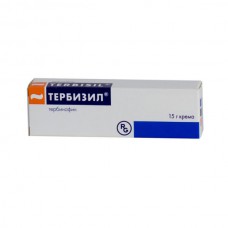Expiration date: 10/2025
The composition and form of issue:
Tablets. 1 tablet contains terbinafine 125 or 250 mg
other ingredients: microcrystalline cellulose (PH 101 and PH 102) polymer carboxymethylcellulose type "A" silicon colloidal anhydrous magnesium stearate
from in blister AL/PVC 14 PCs. in cardboard pack 1 blister (125 mg), or blistere from AL/PVC 14 PCs. in cardboard pack 1 or 2 blisters (250 mg)
Cream. 1 g contains terbinafine 10 mg
Excipients: sodium hydroxide benzyl alcohol sorbitan monostearate cetylpalmitate the cetyl alcohol cetostearyl alcohol Polysorbate 60 purified water methyl ethyl ketone
1% cream in tubes of 15 grams in a cardboard bundle 1 tuba.
Description pharmaceutical form:
Tablets: round, convex tablets white or almost white. On one side, scored and engraved ("125" for tablets of 125 mg "250" tablets of 250 mg).
Cream 1%: white or almost white with a slight odor of almonds.
Pharmacokinetics:
After a single ingestion of 250 mg Terbisil Cmax in plasma achieved within two hours after ingestion and is 0.97 µg/ml. Stable concentrations of the drug are achieved after 10-14 days. The plasma protein binding is 99%.
The drug rapidly diffuses through the dermal layer of the skin and accumulates in the lipophilic stratum corneum. Terbinafine is also secreted in sebum, which makes high concentrations in hair follicles, nails. During the first few weeks after you start taking the drug inside the active ingredient accumulates in the skin and nail plates in concentrations, provides fungicidal effect.
Terbinafine is metabolized in the liver, most of the inactive metabolites excreted in the urine (71%) and less in the faeces (22%).
T1/2 is from 11 to 17 h. indication on the accumulation of the drug in the body do not exist.
Terbinafine is excreted in breast milk.
In patients with impaired renal function or liver the rate of excretion of terbinafine from the body can be reduced.
Changes in pharmacokinetic parameters depending on the age of the patients was not observed.
Eating does not affect the bioavailability Terbisil.
The local application of the cream is absorbed less than 5% of the dose, thus, the systemic effect is minimal.
Description pharmacological action:
Terbinafine is allylamine derivative with a broad spectrum of antifungal activity, drug is used orally and topically. At low concentrations terbinafine has fungicidal action against dermatophytes, yeast and some dimorphic fungi. Action Terbisil in yeast fungi may be fungicidal or fungistatic depending on the species of fungi. The drug specifically inhibits the early stage of the biosynthesis of sterols in the fungal cell. Terbisil acts by inhibition of squalene epoxidase in the fungal cell membrane. This leads to a deficiency of ergosterol and to an intracellular accumulation of squalene, which causes cell death of the fungus. The enzyme skvalenepoksidazu does not belong to cytochrome system P450, therefore
Terbisil does not affect the metabolism of hormones or other drugs. The ingestion and local application Terbisil effective against dermatophytes of the genera Trichophyton, Microsporum, Epidermophyton, the yeast-like fungi of the genus Candida (mainly Candida albicans). The local application Terbisil also effective against Pityrosporum orbiculare (Malassezia furfur) is the causative agent of pityriasis (multicolored) celebrations.
Indications:
Tablets 125 mg:
fungal infections of the scalp.
Tablets 250 mg:
the onychomycosis
fungal infections of the skin
heavy common mycoses (body, legs, feet) and fungal infections of the scalp caused by dermatophytes.
Cream 1%:
infection of the skin caused by dermatophytes and yeast-like fungi, mainly Candida
colorful (pityriasis) versicolor.
Contraindications:
- hypersensitivity to the drug
- pregnancy
- breastfeeding
- children up to age 2 years (table. 125 and 250 mg).
Application of pregnancy and breast-feeding:
Due to the fact that data on the safety of terbinafine in pregnancy no drug should be administered only in those cases where the expected positive effect of the mother outweighs the potential risk to the fetus.
Terbinafine is excreted in breast milk, therefore its use during lactation is contraindicated.
Side effects:
The most frequently observed violations of the gastrointestinal tract (the feeling of fullness, loss of appetite, dyspepsia, nausea, mild abdominal pain, diarrhea) or reactions of the skin (rash, hives).
In rare cases Terbisil may cause a disturbance or loss of taste (recovery occurs within several weeks after stopping treatment).
There are reports of individual cases of cholestasis, jaundice, hepatitis. Although the causal relationship of these disorders with this drug is not established, in the case of the development of hepatobiliary dysfunction treatment Terbisil should be discontinued.
Reported individual cases of serious skin reactions (including Stevens-Johnson syndrome, toxic epidermal necrolysis). If progressive skin rash develops, treatment with Terbisil should be discontinued.
There are some known cases of hematological disorders such as neutropenia and thrombocytopenia.
When applying the cream itching, burning and redness at the site of drug application.
Drug interactions:
Terbisil, unlike azole antifungal drugs, the ingestion has very little ability to slow or increase the clearance of drugs that are metabolized through the cytochrome P450 system (such as cycloserine, tolbutamide, oral contraceptives). Elimination of terbinafine can accelerate the drugs that cause the induction of microsomal liver enzymes (eg rifampicin). In contrast, drugs that inhibit cytochrome P450 (such as cimetidine), and slow elimination of terbinafine. If necessary, the joint use of these drugs may require dose adjustment Terbisil. Cream interact with other medicines are unknown.
Method of application and dose:
Inside (pills), topically (cream). The duration of therapy depends on the nature and severity of the disease. Irregular use or premature discontinuation of treatment leads to relapse.
125 mg. tablets For treatment of fungal infections of the scalp in children. Pill use is indicated only for children older than two years, because there is not enough data about the treatment of children under two years of age (or children with body weight less than 12 kg). When body weight less than 20 kg — 1/2 tab. Terbisil 125 mg (62.5 mg) 1 times a day. And weight 20 to 40 kg, 1 tab. Terbisil 125 mg 1 time per day. Weight above 40 kg — 2 table. Terbisil 125 mg 1 time per day.
Tablets 250 mg. Usually 1 table. (250 mg), 1 time per day.
The onychomycosis: the duration of therapy is usually 6-12 weeks and is determined by the rate of growth of the nail. In some cases, with slow growth of nails, treatment can be longer. The duration of therapy may depend on other factors: the patient's age, presence of comorbidities, the condition of nails at the beginning of treatment. The clinical effect is usually a few months after mycological cure and cessation of treatment. This is due to the regrowth of healthy nails.
Fungal infection of smooth skin: the duration of treatment in the athlete's foot (interdigital localization, plantar, the type of socks) is 2-6 weeks, with mycosis other skin (torso, lower legs) — 2-4 weeks. Duration of treatment for fungal infections of the scalp usually 4 weeks, but when infected by M. canis, it can be longer.
Cream 1%. The cream is applied, gently rubbing on cleansed and dry skin in a thin layer 1-2 times a day. The drug should be applied on the lesion and a portion of healthy skin around it. When treating skin areas under the Breasts, between the toes, in the gluteal and inguinal folds the cream should be applied under the bandage. You must remove the source of infection. Duration of therapy averages: mycosis smooth skin (torso, legs) — 1-2 weeks, fungal infections of feet — 2-4 weeks candidiasis of the skin — 1-2 weeks, pityriasis versicolor 2 weeks.
Elderly patients Terbisil administered in the same doses, as adults. Patients with acute violations of the liver and/or kidney (Cl creatinine <50 ml/min or concentration of serum creatinine >300 µmol/l) should appoint smaller doses Terbisil.
Overdose:
Symptoms: nausea, vomiting, pain in the lower abdomen.
Treatment: gastric lavage, administration of activated charcoal and/or symptomatic therapy.
Data on overdose with topical application of terbinafine no.
Special instructions:
In the presence of severe renal failure (Cl creatinine <50 ml/min or concentration of creatinine in serum of more than 300 µmol/l), and when violation of the liver dose should be halved.
During treatment, it is often necessary to control the level of hepatic transaminases in serum.
If signs of liver dysfunction (weakness, nausea of unknown etiology, loss of appetite, jaundice, dark urine or lightening of the stool) the drug should be discontinued.
Terbisil cream is intended for external use only. It can be applied to the mucous membrane of the eye. When hit the cream in your eyes wash with plenty of water, if necessary consult an ophthalmologist.
Terbinafine does not affect the ability to drive and perform work associated with high concentration of attention.
In the treatment of Terbisil should follow the General rules of hygiene to prevent the possibility of re-infection (through the underwear, shoes).




